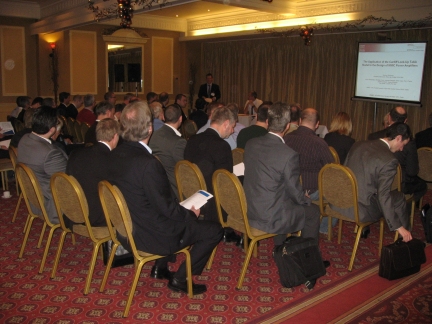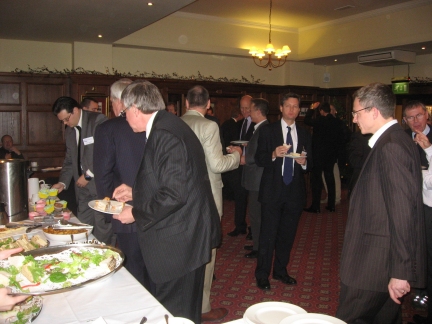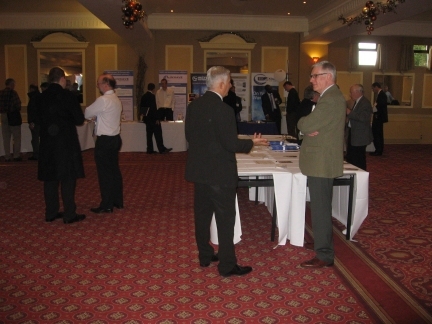 |  |  |
Rockingham Forest Hotel
Rockingham Road
Corby
Northants
NN17 2AE
| Tel | 01536 401348 |
| rockinghamforest@butterflyhotels.co.uk | |
| Web | http://www.butterflyhotels.co.uk/Our_Hotels/Corby/index.php |
Keith Clark
Surrey Satellite Technology
| Tel | +44 (0)1483 803855 |
| K.Clark@sstl.co.uk |
A Comparison of Two Delay Line Discriminator Implementations for Low Cost Phase Noise Measurement | |
| Paul O'Brien | |
| Analog Devices | |
| This paper focuses on low cost production testing of the far-out phase noise of PLL ICs using the delay line discriminator method. It describes two different delay line discriminator (DLD) implementations for phase noise measurements at large frequency offsets from the carrier. The calibration method using an FM calibration signal is described in detail, both mathematically and graphically. The results show good comparison with laboratory based phase noise measurement equipment. | |
| A Comparison of Two Delay Line Discriminator Implementations for Low Cost Phase Noise Measurement | |
Agile L-band amplifiers with independent gain and slope control over a broad dynamic range | |
| Professor Esen Bayar and Graham Q. Quintal | |
| ETL Systems Limited | |
| This paper presents ETL’s latest range of L-band amplifiers. These cover the frequency range from 850 to 2150MHz, and provide independent gain and slope control over a broad dynamic range. The gain characteristics are controllable in 0.5dB monotonic steps from 5 dB to 36dB at 0dB gain vs. frequency slope. At any gain setting, the gain vs. frequency slope can be continuously controlled to give 0 to 8dB of positive slope. This allows correction to the negative gain slope inherent in cable runs and other RF equipment. An extensive range of test data is presented which illustrates repeatable and accurate control of the transfer characteristics, good linearity and noise figure over the amplifiers’ dynamic range. The amplifiers are designed to operate as standalone components and can be readily inserted into 2U high, 19” rack mountable chassis and controlled locally or remotely via web browser interface as well as TCI/IP and serial ports. | |
| Agile L-band amplifiers with independent gain and slope control over a broad dynamic range | |
Antenna Characterisation for Amplitude Comparison in Electronic Warfare Systems | |
| Simon Brown | |
| Institute for System Level Integration | |
| Radar warning receivers listen for pulses from radars of interest. The angle of arrival of each pulse is needed for pulse processing and location purposes. It can be accurately calculated using phase comparison, but this method is often impractical and expensive. This paper describes the authors attempts to use the less accurate method of amplitude comparison to provide adequate accuracy for use in a novel low cost radar warning receiver. | |
| Antenna Characterisation for Amplitude Comparison in Electronic Warfare Systems | |
Commercial GaN Devices for Switching and Low-Noise Applications | |
| Chris Harris and Ray Pengelly | |
| Cree Inc. | |
| Gallium nitride (GaN) RF power transistor and MMIC technologies have become sufficiently mature and reliable in the last few years that there are now very large numbers of fielded devices in both military and commercial applications. Wide bandgap technology is now finding extended use in switching, control and low noise applications. Cree’s GaN on silicon carbide (SiC) MMIC process provides high drain to source breakdown voltage (typically 150 volts) resulting in robust transistor operation allowing, for example, simpler receiver protection circuitry. In addition high output impedances enable large bandwidth of operation; high output third order intercept (TOI) enables lower distortion and higher dynamic range receivers; low noise figures similar to GaAs MESFETs coupled with high fT (27 GHz) enable multi-stage LNA’s to be produced. Application areas for GaN switches, control components and low noise amplifiers include electronically scanned arrays, both military and commercial communications as well as jammers. | |
| Commercial GaN Devices for Switching and Low-Noise Applications | |
Deep Level Dopant Compensated Czochralski Silicon Substrates for MMICs | |
| Dr Kanad Mallik, A. Abuelgasim, Dr C.H. de Groot, and Prof P.A. Ashburn | |
| University of Southampton | |
| The requirement for high resistivity single crystal silicon substrates for microwave monolithic integrated circuit (MMIC) applications above 1 GHz has been underlined in the ITRS Roadmaps, 2007 and 2009. We show that the resistivity of standard Czochralski silicon (Cz-Si) wafers can be enhanced from nominally 50 Ωcm to approximately 15 kΩcm, measured at about 20 oC using compensation by deep level (DL) impurity states of gold (Au), which was implanted into Cz-Si. We proposed a fully encapsulated Au-doped handle wafer for a SOI wafer configuration to solve the problem of Au contamination of the active wafer. The details have been discussed in our previous publications and a patent. In the present paper, we show significant reduction of RF attenuation in 1-40 GHz range in the DL-doped Si wafers, measured using co-planar waveguide (CPW) test structures fabricated on the material. Notably, the DL-doped wafers have a bi-layer resistivity profile. Our full 3D electromagnetic simulations using Ansys/Ansoft HFSS show significant enhancement of the quality (Q) factor of spiral inductors made on the material. | |
| Deep Level Dopant Compensated Czochralski Silicon Substrates for MMICs | |
Demonstration of Flexible 240W GaN SSPA for Space Application | |
| C D Seymour, C R Green, M D Goss | |
| EADS Astrium Limited | |
| The paper will present the performance of a 200W S Band Gallium Nitride (GaN) SSPA with flexible output power capability. This pre-flight demonstration unit incorporates proven flight design features, and all active components are fully space qualified. By incorporation of elements of the EADS Astrium adaptive 'Flexamp' technology, the SSPA demonstrates high efficiency over a 6dB output power range, with a consequential DC power saving of over 80W at 6dB Output Power Back-off compared to fixed class A/B operation. It is considered that this SSPA pioneers the way towards a new class of EADS Astrium high power spaceflight SSPA products incorporating GaN technology. | |
| Demonstration of Flexible 240W GaN SSPA for Space Application | |
Design and Testing of High Voltage RF Electronics | |
| Mark Walden and Roscoe Harrison | |
| Roke Manor Research Ltd | |
| When one mentions High Voltage RF electronics, one thinks of the valve amplifier where the anode and grid supplies can be in the hundreds if not thousands of volts. But in a world where low voltage solid state devices are more usual, is there still a place for HV RF? We believe that there is, and to show our confidence in this, Roke has invested in a world beating High Voltage Testing Facility that is suitable for use up to 18GHz. In this paper we will describe the recent HV RF activities that have been performed at Roke. The paper concentrates on work to significantly extend the duty cycle of a VHF SSPA design to make it more attractive for scientific, medical, and other less obvious applications where valve amplifiers still dominate. We shall also discuss techniques and infrastructure for safely testing HV RF devices, from relatively simple interlocked test jigs to the workings of our new High Voltage Testing Facility. | |
| Design and Testing of High Voltage RF Electronics | |
Improved infrared temperature measurement of RF devices | |
| R H Hopper, D Prime and C H Oxley | |
| De Montfort University, Leicester | |
| The presentation will describe the infrared (IR) thermal measurement facility at De Montfort University and the use of the facility to make conventional IR temperature measurements on RF devices. Some of the limitations with the conventional IR measurement technique will be described; including effects related to the low emissivity and optical transparency of materials. A novel method for improving the accuracy of IR temperature measurements has been developed. By measuring the level of IR radiation emitted by high emissivity micro-particles, placed in isothermal contact with an electronic device, an indirect estimate of its surface temperature can be obtained. The presentation will show how the “micro-particle” technique has been used to make improved IR temperature measurements on GaAs Gunn diodes and GaN high electron mobility transistors (HEMTs). | |
| Improved infrared temperature measurement of RF devices | |
Low-power, Low-cost and Low-voltage ISM band oscillator Using Discrete Components and a Miniaturized Resonator | |
| Kwok Lui, Antonio Vilches | |
| Imperial College | |
| In this paper, a low-voltage and low-power 2.4GHz LC-oscillator using discrete components on FR-4 is presented. This LC-Oscillator requires only 1.8V to operate and the optimized layout is implemented on low-cost conventional double layer PCB without using an additional layer for connection between the miniaturized resonator and transistors. The dimension of the PCB is only 32 mm x 21 mm. Measured results show the circuit consumes only 2.56mW using a supply voltage of 1.8V, with phase noise of -119dBc/Hz at 1-MHz offset. Further experiment shows that it can operate at 1.1 V with power consumption only 0.69 mW. | |
| Low-power, Low-cost and Low-voltage ISM band oscillator Using Discrete Components and a Miniaturized Resonator | |
Metrology Issues in THz Spectroscopy, Imaging and Communications | |
| Dr Mira Naftaly | |
| NPL | |
| THz spectroscopy and imaging have gained widespread use in research and are beginning to find niche applications in industry. THz communications pose many technological challenges, yet also promise great advantages for high bit-rate short-distance links. As the field matures, metrology issues and standards are becoming increasingly important. The talk will describe measurement techniques in THz spectroscopy and imaging and related calibration methods for frequency, amplitude, resolution and dynamic range. The standards and protocols demanded by the evolving technologies of THz communications will also be discussed. | |
| Metrology Issues in THz Spectroscopy, Imaging and Communications | |
The Application of the Cardiff Look-Up Table Model to the design of MMIC Power Amplifiers | |
| Dominic FitzPatrick | |
| PoweRFul Microwave | |
| The design of microwave power amplifiers has been greatly enhanced by the use of CAD, however despite improvements in the area of E-M simulation and non-linear analysis, designs still need to be ‘tweaked’. While this is a practical option for discrete amplifiers it is extremely difficult in the MMIC domain. The requirement for higher efficiency operation and hence the use of modes such as class F and J have highlighted inadequacies in current models. This paper describes the integration of waveform engineering not only into the device measurement area, but into the MMIC design process. The practical limits on current nonlinear models are discussed and an example design, using harmonic enhancement, is shown. | |
| The Application of the Cardiff Look-Up Table Model to the design of MMIC Power Amplifiers | |
The Fully Automated Optimisation of a Microwave HPA using Signal Injection and Differential Evolution | |
| Alex Scarbro | |
| Linwave | |
| This paper will discuss how the manual optimisation of a high power amplifier was replaced with a fully automated ATE. The rationale for selecting Differential Evolution will be demonstrated and suitable cost functions explained. The development of a highly re-usable LabView based global optimiser will be shown and its practical applications in “real-world” problems demonstrated. | |
| The Fully Automated Optimisation of a Microwave HPA using Signal Injection and Differential Evolution | |
Using VSS for RADAR system design | |
| Steve Tucker | |
| Applied Wave Research Ltd | |
| Radar system analysis needs to account for both the performance of the electronic system as well as modelling the target in its environment. Many modulation types are available to the Radar system designer ranging from short pulse, long pulse, ICWFM, short and long pulse Chirp. This presentation will outline the use of a system simulator with demonstration examples appropriate to these diverse Radar modes. | |
Wideband Component Design - Directional Couplers | |
| John Kitchen | |
| SJ Technologie Ltd | |
| The paper will discuss the implications of coupling ripple versus bandwidth for the component, the different options for designing such a component, the trade-offs with each design option and the limitations of each. | |
| Wideband Component Design - Directional Couplers | |
Anybody interested in exhibiting at furtue meetings please email exhibition@armms.org.
Contributions are invited with an emphasis on RF and microwave design, research, testing and associated subjects. An oral presentation will be made at the meeting and a written paper will be required for publication in the society digest, which is distributed to delegates at the meeting. Prospective speakers are requested to submit a title and a short abstract to the technical coordinator (see above) as soon as possible.
Click here to view our Guidelines for Authors
Click here to view our Publication Release Form